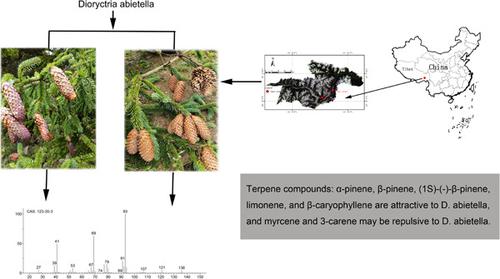当前位置:
X-MOL 学术
›
Arch. Insect Biochem. Physiol.
›
论文详情
Our official English website, www.x-mol.net, welcomes your
feedback! (Note: you will need to create a separate account there.)
Relationship between volatile compounds of Picea likiangensis var. linzhiensis cone and host selection of Dioryctria abietella.
Archives of Insect Biochemistry and Physiology ( IF 1.5 ) Pub Date : 2020-09-07 , DOI: 10.1002/arch.21733 Xiaoqin Tang 1, 2, 3 , Tan Gao 2, 4 , Jie Lu 2, 4 , Dawei Hong 1, 3 , Xianming Tong 1, 3 , Yihua Ren 2, 4
Archives of Insect Biochemistry and Physiology ( IF 1.5 ) Pub Date : 2020-09-07 , DOI: 10.1002/arch.21733 Xiaoqin Tang 1, 2, 3 , Tan Gao 2, 4 , Jie Lu 2, 4 , Dawei Hong 1, 3 , Xianming Tong 1, 3 , Yihua Ren 2, 4
Affiliation

|
This study aimed to determine the relationship between volatile compounds of Picea likiangensis var. linzhiensis cone and host selection of Dioryctria abietella. During the infestation of P. likiangensis var. linzhiensis by D. abietella, their cones and branches emitted volatile compounds, which were extracted using CH2Cl2 extraction and XAD2 adsorption methods, and were analyzed using gas chromatography–mass spectrometry. Before and after overwintering, D. abietella larva preferred annually infested cones and their extracts, and adult D. abietella preferred to lay eggs on annually infested cones and healthy cones of the year, and the oviposition rate of adult D. abietella was 72% on branches with healthy cones of the year, and no egg was laid on branches with annually healthy cones or branches without cones. The volatile compounds after infestation, α‐ and β‐pinene, were significantly higher in cones than those in other tissues; however, myrcene in cones was significantly lower than those in other tissues. The annually infested cones produced β‐caryophyllene and (1S)‐(‐)‐β‐pinene, while the annually healthy cones and branches produced myrcene and 3‐carene. The annually infested cones and their extracts attracted D. abietella larvae, while that of healthy cones and annually infested cones attracted the adults, indicating that the terpene compounds: α‐pinene, β‐pinene, (1S)‐(‐)‐β‐pinene, limonene, and β‐caryophyllene are attractive to D. abietella, and the terpene compounds—myrcene and 3‐carene—from the branch tissues may be repulsive to D. abietella.
中文翻译:

云杉云杉挥发性成分之间的关系。临cone锥果和寄主松果的选择。
本研究旨在确定云杉云杉挥发性成分之间的关系。林芝锥果与松果薯的寄主选择。在丽江疫霉侵染期间。linzhiensis由D. abietella,其锥和发射挥发性化合物分支,其使用提取出CH 2氯2提取和XAD 2吸附方法,以及使用气相色谱-质谱法进行分析。越冬前后,D。abietella幼虫更喜欢每年感染的视锥细胞及其提取物,以及成年的D. abietella首选在每年感染的视锥细胞和一年生的健康视锥细胞上产卵,当年具有健康视锥细胞的分支上成年D. abietella的产卵率是72%,并且在每年健康的视锥细胞的分支或无视锥细胞的分支上不产卵视锥细胞。侵染后,锥体中的挥发性化合物α-和β-ne烯显着高于其他组织。然而,视锥细胞中的月桂烯含量明显低于其他组织。每年感染的视锥细胞产生β-石竹烯和(1S)-(-)-β-pine烯,而每年健康的视锥细胞和分支产生月桂烯和3-胡萝卜素。每年出没的球果及其提取物吸引了D. abietella幼虫,而健康视锥和每年被感染的视锥吸引成人,这表明萜烯化合物:α-pine烯,β-pine烯,(1S)-(-)-β-pine烯,li烯和β-石竹烯对枞树和分支机构中的萜烯化合物(月桂烯和3-胡萝卜素)可能会排斥枞树。
更新日期:2020-10-12
中文翻译:

云杉云杉挥发性成分之间的关系。临cone锥果和寄主松果的选择。
本研究旨在确定云杉云杉挥发性成分之间的关系。林芝锥果与松果薯的寄主选择。在丽江疫霉侵染期间。linzhiensis由D. abietella,其锥和发射挥发性化合物分支,其使用提取出CH 2氯2提取和XAD 2吸附方法,以及使用气相色谱-质谱法进行分析。越冬前后,D。abietella幼虫更喜欢每年感染的视锥细胞及其提取物,以及成年的D. abietella首选在每年感染的视锥细胞和一年生的健康视锥细胞上产卵,当年具有健康视锥细胞的分支上成年D. abietella的产卵率是72%,并且在每年健康的视锥细胞的分支或无视锥细胞的分支上不产卵视锥细胞。侵染后,锥体中的挥发性化合物α-和β-ne烯显着高于其他组织。然而,视锥细胞中的月桂烯含量明显低于其他组织。每年感染的视锥细胞产生β-石竹烯和(1S)-(-)-β-pine烯,而每年健康的视锥细胞和分支产生月桂烯和3-胡萝卜素。每年出没的球果及其提取物吸引了D. abietella幼虫,而健康视锥和每年被感染的视锥吸引成人,这表明萜烯化合物:α-pine烯,β-pine烯,(1S)-(-)-β-pine烯,li烯和β-石竹烯对枞树和分支机构中的萜烯化合物(月桂烯和3-胡萝卜素)可能会排斥枞树。











































 京公网安备 11010802027423号
京公网安备 11010802027423号